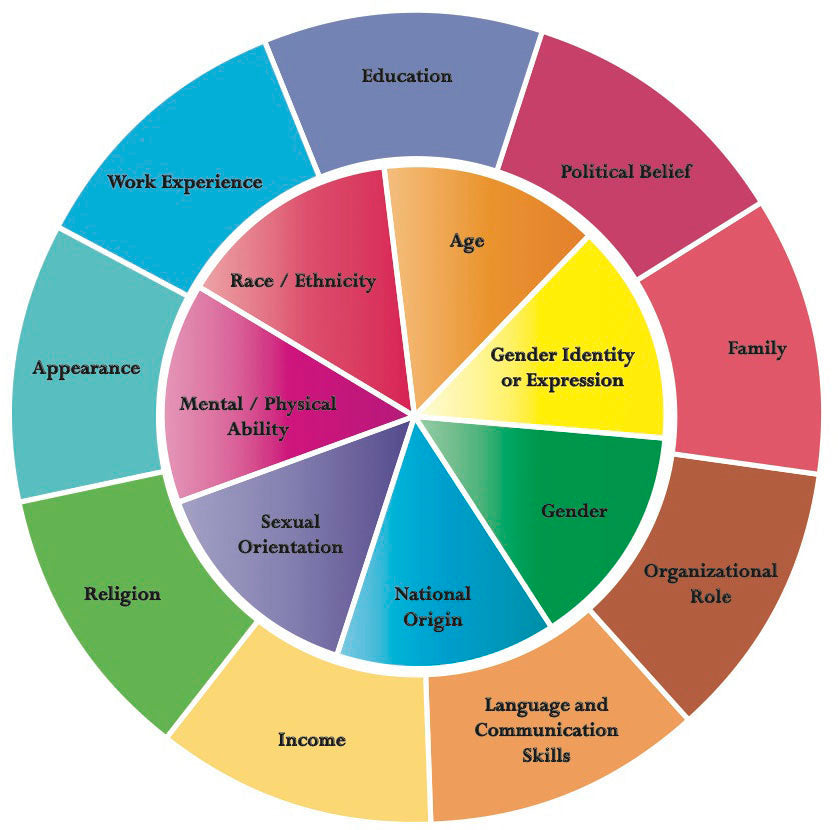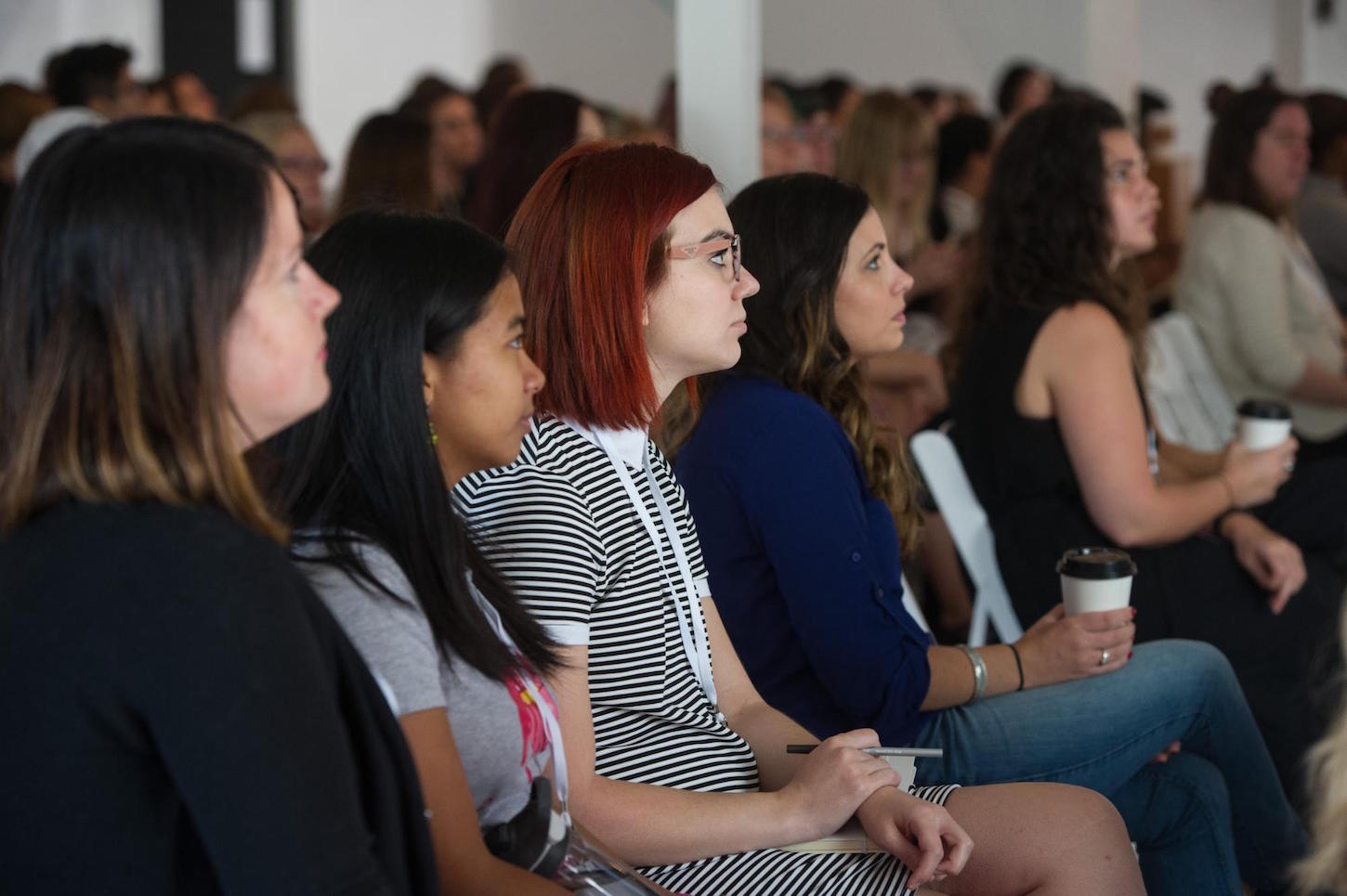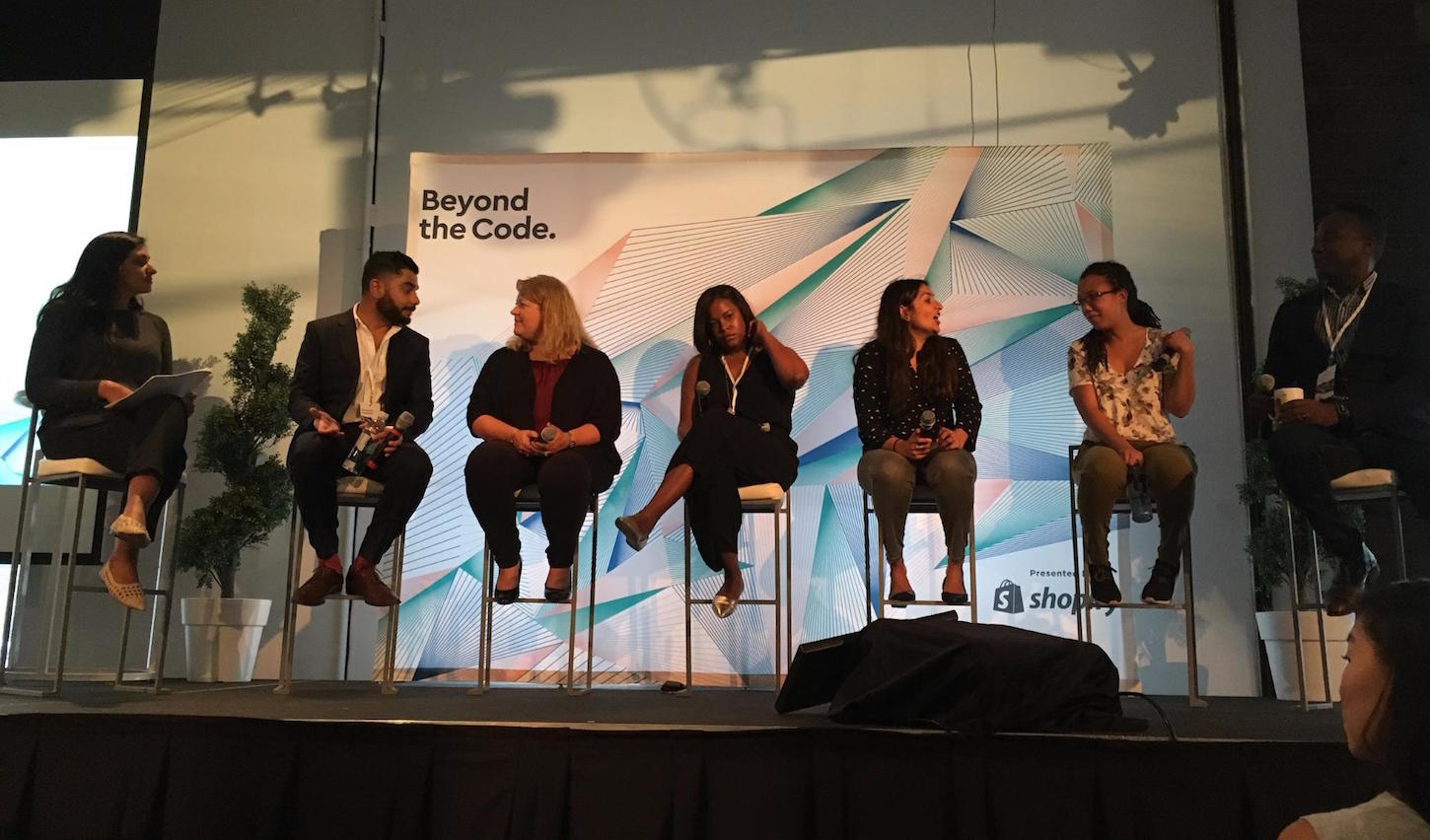Waiting on a tarmac at Billy Bishop Airport in Toronto, my stomach churned. I was already cutting it close to the opening of Beyond The Code, a conference organized by Shopify on diversity, and now this damn plane wouldn’t move.
Shit. I’m. Late.
Twenty minutes, a LONG bathroom line, and an angry cabbie later, I arrived stressed out at the doors of the conference.
And that’s when it happened: my bad mood instantly softened.
I gingerly walked past the pearly white patio gates with fun swag in tow, and entered a bright room with lots of smiling faces. People were chatting, chowing down on scones, creating art, and writing down how they plan to make the tech world more inclusive.
It looked like some of the conferences I’ve attended in the past, but something felt different. The big city schmoozing I’d come to expect from these events was nowhere to be found — no, this was something different, something more authentic…dare I say it, something special.
Not only was Beyond the Code talking about diversity and inclusion in technology, but you could actually feel it in the air. Organizers, speakers, and attendees were all there with the genuine and lionized hope of putting diversity in technology at the forefront of our discussions, decisions, and day-to-day work-life.
There was something grassroots about this intimate conference. It sprouted from the promising intentions of the attendees, their desire to see change, their curiosity about how to ask the right questions, their anger in the face of discrimination.
It was downright inspiring.
So much so, that I’ve decided to share with you, fair Internet reader, the top eight things I learned at this year’s Beyond The Code.
1. The origin story of Beyond The Code
When Anna Lambert of Shopify, who started Beyond The Code in 2014, took the stage to officially open the conference, she explained a bit about how the event first came to be.
 After attending a conference with only male speakers, Anna approached organizers and asked why they hadn’t included any qualified female speakers. The organizers replied that there weren’t any.
After attending a conference with only male speakers, Anna approached organizers and asked why they hadn’t included any qualified female speakers. The organizers replied that there weren’t any.
“I told them, ‘then you’re not looking hard enough,’” Anna told the crowd plainly.
And voila, Beyond The Code was born. Nothing like pissing off a badass female, eh?
2. What the ‘Wheel of Diversity’ is
When Shopify’s Director of Apps, Atlee Clark, started talking about using the Wheel of Diversity, I won’t lie, I started thinking about old game shows. Luckily, Atlee is particularly adept at shedding light on complex problems, and instantly grabbed my attention with her explanation.
"I believe great decisions come from gathering and valueing diverse perspectives" #wisewords @atleeclark #BeyondTheCode pic.twitter.com/Mc42gpK5vQ
— Shopify Partners (@ShopifyPartners) September 22, 2016
"I believe great decisions come from gathering and valuing diverse perspectives," Atlee said. “But how do we include diversity in our daily practice?”
That’s where the Wheel of Diversity comes in. Meant to be used as a tool, this wheel maps out the different perspectives each person can bring to the table.
- The inner wheel contains ‘inherent dimensions’ that we have no control over, many of which we are born with.
- The outer wheel includes ‘acquired dimensions’ that we have a bit more control over, and that change over the course of our lifetime.
Whether it’s a religious belief, biological trait, or a lived experience, Atlee explained, it’s important to understand your individual perspective and what you bring to a team that’s unique. And for those in positions of leadership, it’s important to understand where each of your team members come from.
“This is a visual gut check on who you’re bringing to the decision table,” Atlee added.
When we value diversity while making daily decisions, it trickles down (and even up).
3. Thomas Edison was a notorious napper
Nick Serjeant of Facebook offered more than a few wise words for managing your career in the hacker world. These pearls varied from advising us to take risks, to get outside our comfort zone often, and to “be the nerd,” aka be your authentic self.
"What all the great innovators of our time have in common is that they made the unpopular choice," Nick explained. But what really caught my attention was the fact that Thomas Edison was a notorious napper (especially considering the man publicly regarded sleep as a waste of time). While this fact just thrills me on its own, the point was that after his power naps, Edison came back to his work reinvigorated and ready to produce his best ideas.
But what really caught my attention was the fact that Thomas Edison was a notorious napper (especially considering the man publicly regarded sleep as a waste of time). While this fact just thrills me on its own, the point was that after his power naps, Edison came back to his work reinvigorated and ready to produce his best ideas.
This tidbit was Nick’s way of explaining that down time is key to success.
“I get my best ideas when I’m brushing my teeth, when I can zone out a bit. The point is, you need to make sure you let yourself find those opportunities where you can clear your mind.”
Often, many of us don’t feel like we can turn our Slack off for the evening, take that vacation, or spend weekends with ourselves/the ones we love most. And it never helps when you’re watching colleagues or competitors around you burn the midnight oil.
“Anyone can work themselves ragged. The key is to make sure you ruthlessly prioritize within those 40 hours,” Nick added.
4. Inclusion does not equal feeling included
This lovely little nugget came from Jamie Chung, a developer from Dropbox who identifies as non-binary and gave an amazing talk that compared transitioning in CSS to transitioning in gender.
What struck me most about Jamie’s speech was their frankness about diversity and inclusion. It’s not a magical kumbaya moment; it takes work, and often discomfort, and definitely some gracious and patient folks willing to pave the way forward.
Pro tip: instead of saying sorry, try rephrasing your answer to say thank you #takeownership Jamie Chung, Dropbox #beyondthecode pic.twitter.com/aA6JAT98Oq
— Christina Lord (@thelordify) September 22, 2016
But nothing was more poignant than when Jamie said to their audience, “inclusion does not equal feeling included.”
“Just because you have a diversity program doesn’t mean you're respecting needs or are asking hard questions,” they added.
And it goes beyond just programs crafted by large corporations and organizations. It’s awesome that you hold a weekly team lunch where everyone is welcome, but it doesn’t mean you’re creating spaces where people feel they can be their authentic selves. If you’re a leader within your business or organization, consider learning how to create safe spaces and how to ask awkward questions (so you can create those safe spaces!).
5. Female entrepreneurs are more likely to be successful when they’re mentored by a female investing partner
Janet. Oh, Janet. Wow, Janet.
A partner in Canadian venture capital firm RealVentures, Janet Bannister is just downright impressive. From young entrepreneur, star athlete, and head honcho at Kijiji Canada, to helping female entrepreneurs just kill it, Janet dropped a few wisdom bombs during her Beyond The Code Q&A.
"Make the big decisions with your heart, smaller decisions with your head" - @jebannister at #beyondthecode pic.twitter.com/9ithLw4oRJ
— Craig Miller (@craigmillr) September 22, 2016
One of the biggest insights she shared was the fact that female entrepreneurs often undervalue their businesses in comparison to male entrepreneurs.
“Everybody is different, but generally speaking, men set the bar super high and are aggressive about their growth projections and think, ‘I don’t know how I’m going to do it, but I’ll figure it out,’” Janet explained. “Women go in and pitch much lower growth projections, with the thought, ‘I want to make sure I hit these projections.’”
While women tend to underplay their businesses, research also shows female entrepreneurs benefit tremendously from mentorship (which increases when that mentor is an investing partner).
“The lesson there for me was learning how to mentor and work with female entrepreneurs to help ensure their success.”
6. The difference between a mentor and a sponsor
Lateesha Thomas, Director of Diversity at Dev Bootcamp, mentioned this difference while speaking on a panel covering inclusion, and I swear I could feel various brains in the room think, “yeah, what the hell is the difference?” “The difference is what’s at stake,” she explained. “Sponsorship is when someone is actively giving you something and there’s something at risk.”
“The difference is what’s at stake,” she explained. “Sponsorship is when someone is actively giving you something and there’s something at risk.”
One example Lateesha gave was writing a proposal to create a completely new position at your company and pitching it to your boss or a higher up. If they concede, they’re giving you a leg up and a shot at something.
“It's a mix between creating my own opportunities and asking for help,” she added.
By contrast, mentorship is more about a one-on-one relationship you build, Lateesha explained. It’s more about going out for a cup of coffee with someone who isn’t necessarily going to get you a job, but who can offer guidance and advice on how to achieve your next career move.
7. Only 1% of high school girls in the U.S. are considering studying computer science
 Okay, so this little nugget of information is a bit more depressing than anything else. But the good news? There are lots of ways to help ensure change happens. For example, Sabrina Geremia with Google Canada discussed how their initiative Made with Code is working to empower young women to learn computer programming skills.
Okay, so this little nugget of information is a bit more depressing than anything else. But the good news? There are lots of ways to help ensure change happens. For example, Sabrina Geremia with Google Canada discussed how their initiative Made with Code is working to empower young women to learn computer programming skills.
What was interesting about Sabrina’s talk was that she gave actionable tips on empowering the girls in our own lives. Sabrina’s brother bought her a computer when she was only a kid and encouraged her to learn how to use it. Whether it’s taking your niece to a local maker festival, buying your daughter Goldie Blox for Christmas, or helping your little sister make a robot (you’d be #1 best sibling ever), there are lots of ways to introduce computer science to girls and ensure they’re not missing out.
And if you don’t think it’s important to encourage your daughters, sisters, or nieces to think about computer science, consider this fact: only 18 per cent of computer science grads in the US are women.
8. Tech companies big and small are thinking about diversity
One of my favorite moments of the day was the final panel discussion, which included several people of different genders, races, ethnicities, backgrounds, and sexual orientations, from organizations big and small, like Google, TWG, and Microsoft. Whether it was discussing the alarming news that women are leaving the tech industry at double the rate men are, debating the merits of white male mentors, or how to hire with diversity in mind, each panelist was pretty raw and unfiltered.
Whether it was discussing the alarming news that women are leaving the tech industry at double the rate men are, debating the merits of white male mentors, or how to hire with diversity in mind, each panelist was pretty raw and unfiltered.
My biggest takeaway listening to each panelist discuss challenges and realities was that there’s a very long road ahead of us to achieve true diversity and inclusion. But there are lots of great people across our industry that are asking hard questions, pushing themselves into tough situations, and challenging the status quo. That in itself is pretty awesome.
Scratching the surface
Like I said, this is just a glimpse of all the amazing talks and discussion that happened at Beyond The Code, and truly only scratches the surface of what diversity encompasses.
If you’re interested in learning more, keep an eye out for Beyond the Code recordings, set to be available in the coming weeks.

